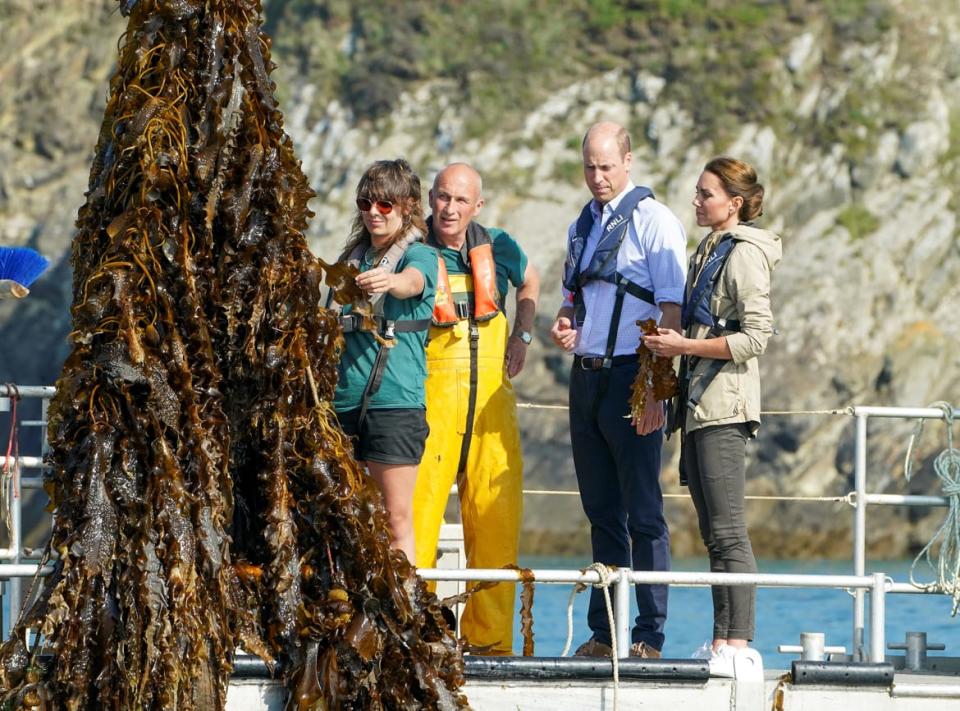Inside the Great British Seaweed Race to Save the Earth

Under the waters of the North Atlantic, hundreds of meters of seaweed rope lines used to farm algae are being strung up—the magic ingredient, a growing clutch of startups believe, in fighting climate change. While 97 percent of seaweed farming currently happens in Asia, British companies are looking to muscle in on the $13.3 billion industry—and maximize on the natural advantages their location brings to regenerate the planet.
Given the scale of Asia’s operation, the U.K. has its work cut out. But it’s a challenge that Olly Hicks believes is worthwhile "in myriad different ways." Hicks, the first person to row solo across the Atlantic from the U.S. to the U.K., is the founder of Algapelago, an algae farm in Bideford Bay, four miles from the coast of North Devon in southwest England. He has secured a license to cultivate a nearly 300-acre area along with his cousin Humphrey Atkinson, product manager at Notpla, a startup that uses seaweed as a biodegradable replacement for single-use plastics.
While Notpla and other enterprises focus on harnessing the aquatic plant for packaging, food, and cosmetics, Algapelago is working on a less-common use for the slimy stuff: cow feed. A 2021 study from the University of California, Davis found that mixing a small amount of seaweed into cow feed over five months reduced Earth-polluting methane emissions by 82 percent—making it a potential green goldmine.
Climate Change Is Literally Changing the Ocean’s Color
Soy has become “a major agent of deforestation,” Hicks told The Daily Beast, with large swaths of rainforests being plundered to plant the crop. In fact, 80 percent of all soy grown is for agricultural feed. “If we could replace, say, 2 percent of cow’s feed with seaweed rather than soy on a bigger scale, that’s a pretty significant impact."
Algae production for commercial use tripled globally between 2000 and 2019, and appetite for more appears to be blooming in Britain. Between 2016 and 2022, the number of commercial seaweed enterprises in the U.K. rose from one to 10. Last year, the Scottish Association for Marine Science set up the Seaweed Academy in Oban in the West Highlands, as a result of the influx of calls from people wanting to set up algae farms of their own.
Still, despite the rising interest, these small-scale offerings are eons away from the organizations churning out the majority of the world’s 36 billion annual tonnes of algae. And typically, the smaller the company, the less likely they are to rely on the cheap labor and mechanized processes employed by many of Asia’s most lucrative firms. That means the wild harvested seaweed offered by Algapelago costs 10 times more. Cost remains the rub for producers and consumers alike—and things are likely to continue that way for the foreseeable, Hicks says, as “the market is not yet ready to accept the price premium of that sustainability.”
You May Be Inhaling a Credit Card-Sized Worth of Microplastic Each Week, Study Finds
In June, a report from the United Nations Environment Programme “recognize[d] the growing global interest in seaweed farming,” concluding that identifying areas where seaweed farming could be expanded “can contribute to society, particularly towards solutions to the urgent climate crisis.”
Scott Spillias, a PhD student analyzing the potential role of seaweed farming at the University of Queensland, Australia, told The Daily Beast that “the best-case scenario for seaweed farming at any scale is that it generates food and material we can use for a variety of applications, whilst providing a regenerative role in the marine environment and enhancing local and global resilience to climate change.”

The Prince and Princess of Wales visited the Car-Y-Mor Seaweed Farm St Davids, Pembrokeshire in Wales and a key partner of Notpla, the sustainable packaging start-up and winner of the 2022 Earthshot Prize for 'Build a Waste-Free World', in St Davids, Wales, Britain, Sept. 8, 2023.
One of the biggest benefits touted by supporters is its propensity for carbon capture: removing CO2 from the atmosphere through photosynthesis and storing it away for up to millennia as the plants sink to the ocean floor. To meet international climate goals, estimates from a paper published in June in the journal Communications Earth and Environment suggest that more than 4 gigatons of carbon dioxide would need to be removed from the atmosphere each year until 2050—but seaweed farming’s role in that “remains highly uncertain.”
Reaching that target would require tripling the cultivation area for seaweed, the paper said, adding that there are also challenges to overcome in improving the annual harvest, including better understanding the biophysical constraints posed by the likes of infestation, wave erosion and disease.
These Tiny Robots Could Usher in the Future of Clean Water
“Even more limiting are the technical and socioeconomic challenges associated with farming the ocean," Spillias explained, like “how to design farms that can endure extreme weather events, how to make the enterprise economically viable, and how to implement policy frameworks that allow for seaweed farming amongst myriad other ocean uses.”
He added, “I don’t imagine we’ll be replacing current systems with seaweed-based ones any time soon.”
This may sound like bad news for the seaweed startups like Hicks, but he’s well aware of the roadblocks ahead. Algapelago's original plans to create 250 rope lines (after starting out with two) are regularly being adapted. “We’re more conservative than when we started,” he said. While it’s tempting to believe seaweed farming is “a panacea,” Hicks knows that its real benefits are still “absolutely far from academically agreed.”
In the meantime, Algapelago continues to dedicate part of their farm to research and development, working alongside universities to measure and quantify the impact their much-vaunted seaweed may have. They hope it will yield the benefits they suspect, but only time will tell. Until then, Hicks said that “it’s the Wild West” beneath the sea.
Get the Daily Beast's biggest scoops and scandals delivered right to your inbox. Sign up now.
Stay informed and gain unlimited access to the Daily Beast's unmatched reporting. Subscribe now.

